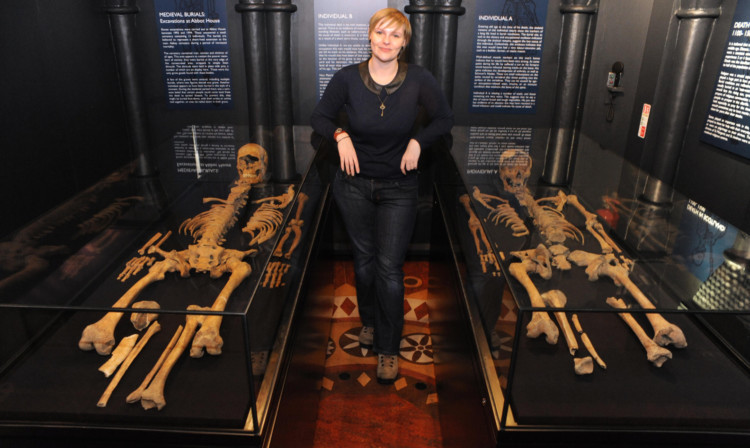The bare bones of life and death in medieval Fife will be on display from Friday when a controversial exhibition featuring human remains opens its doors.
Voices From the Past: Life and Death in Medieval Dunfermline at Abbot House aims to illustrate the way in which people lived and died during the 14th Century.
The exhibition features two male skeletons, which will be on show for optional viewing in a side room. This is the first time the skeletons have been put on public display, after being moved in the 1990s following essential works to lay new pipes in the garden of the property.
The exhibition has sparked criticism from former honorary past president of Dunfermline Heritage Trust Sheila Pitcairn, who described it as “immoral”.
Abbot House human osteoarcheologist and Heritage Lottery Fund project officer Gillian Ramsay claimed, however, that the exhibition is a way of paying tribute to the two individuals.
Gillian, who has spent the last three months painstakingly rebuilding the skeletons after removing them from storage, said: “This is an exciting way of sharing their story. The skeletons are from the mid-1300s. We have all the bones, apart from a few missing toes, and we know they were both male one a stocky, 5ft 4in older man and one a younger man, around 5ft 8in and in his twenties.
“We know they were very poor people because of their bone structure and also the simple way they were buried. There were no coffins, for example instead they were wrapped in shrouds tied with pins.
“There was also no jewellery or anything fancy on or around them.
“Traditionally, the rich would be buried as close to the abbey as possible, whereas the poor were the furthest away, which was the case for these two men.
“The teeth of the older man were in a bad state with most of them missing, indicating a rough diet and muscle markers on his skeleton suggest he did a very labour-intensive job involving lots of lifting.
“The younger man has a fantastic skull and quite a feminine jawline and has better teeth. There is nothing indicating any diseases or injuries so trying to work out his cause of death is difficult but we think it must have been something short-lived like a fever or a bad cold.
“He also has a lot of genetic traits such as a hole in his sternum and a missing molar.”
Gillian said she believes the two men were both Catholic but could not be sure because many people turned away from their churches at the time of the plague because they felt their prayers were not being answered.
“Another thing we are not sure of is why they were buried together,” she added.
“It is very intriguing as this is not normal Christian tradition. There is no indication they were related so perhaps a lot of people died at the one time, resulting in multiple burials simply out of convenience.”
Gillian urged members of the public to go along and learn more about the skeletons and how people lived in medieval Fife.
“They represent the poorest people in society at that time and I think we are giving them back an identity. We can also, through them, learn abut our own history.
“Dunfermline is so much about the history of St Margaret, King Malcolm and Robert the Bruce, but you never hear about the working class people who built the palace and the abbey and helped shape the town we live in today.”
As well as the skeletons, other objects from various excavations carried out at Abbot House over the years will also be on display. These include pottery items, belt buckles, leather shoe soles, betting chips, hunting items and even whale bones.
Gillian added: “The entire exhibition represents the life cycle of the people who lived in medieval Dunfermline and we look forward to sharing it with as many people as possible.”
Photo by David Wardle
